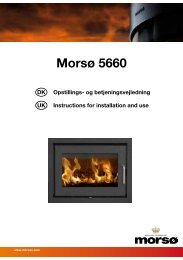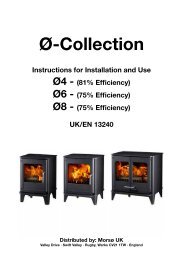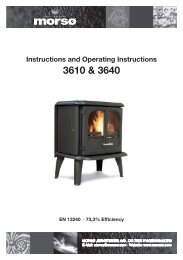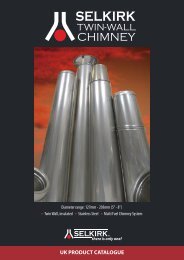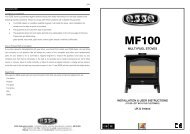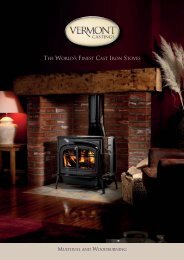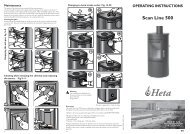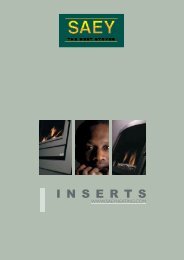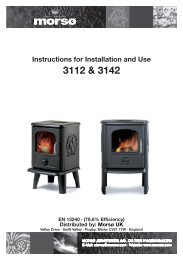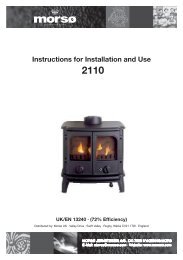View - Stoves Online
View - Stoves Online
View - Stoves Online
You also want an ePaper? Increase the reach of your titles
YUMPU automatically turns print PDFs into web optimized ePapers that Google loves.
2.0 Firing/using the stove<br />
Your stove is constructed with air inlets in two places.<br />
Pre-heated, fast-moving combustion air is added to the fire above the glass window, and is<br />
regulated using the handle above the door. The combustion air is let in when the handle is<br />
pushed to the right, and shut off when the handle is pushed to the left.<br />
Another air inlet provides a constant, pre-heated air supply which cannot be adjusted, and<br />
which comes into the combustion chamber just above the fire. This helps to burn off the last<br />
few gasses emitted by the wood whilst it is being heated up.<br />
The stove’s rated heat output is 6,2 kW. Your new Morsø stove is EN-tested for firing with<br />
wood, and is suitable for intermittent use.<br />
N.B!<br />
Wood is a material that contains a great deal of gas (approximately 75 %). The gases<br />
are released when the wood is lit and heated up. For this reason, it is important that<br />
the gases are ignited quickly after stoking. If the wood just lies smouldering, especially<br />
after re-stoking, a lot of smoke is created, which, in the worst case, may cause<br />
an explosive ignition of the gasses, resulting in damage to the stove.<br />
In order to ignite the gases that are released from the wood, and to keep clear, lasting<br />
flames during the combustion process, it is important to let in the required quantity<br />
of oxygen (air supply) at all times. The setting of the air supply, the method of ignition<br />
and the lighting intervals depend on the draught in the chimney, the wind and<br />
weather, the amount of heat required, the fuel, etc. This means that it may take some<br />
time before you get to know the correct functioning of the stove under any given circumstances.<br />
Although you can fire your Morsø stove with almost all kinds of wood, you should not<br />
fire with wet wood, or unseasoned wood. Wood ought to be stored under a roof for at<br />
least 1 year, and preferably 2 years, with free access to wind. Wood should be chopped<br />
as soon as possible after felling if it is to dry quickly. The wood can be used once<br />
the moisture content is less than 20%. During the EN test, all stoves are tested with<br />
wood with a moisture content of (16 ± 4)%.<br />
Never use driftwood, as it usually has a high salt content, which damages both the stove<br />
and the chimney. Impregnated and painted wood and chipboard emit poisonous<br />
smoke and fumes, so they should not be used as fuel either.<br />
Please note that liquid fuel may not be used in the stove.<br />
Pieces of wood with a diameter greater than 10 cm should always be chopped.<br />
The pieces of wood should be short enough to be able to lie flat over the layer of embers,<br />
with air at both ends.<br />
The maximum length of fuel in the stove is 30 cm.<br />
The maximum quantity of fuel is 2 kg/hour (max. 2 pieces of wood each time you restoke).<br />
The first few times you light the stove, the fire should be moderate, so that the heatresistant<br />
paint can harden before firing more vigorously. During the hardening phase,<br />
the paint may develop obnoxious smoke and smell the first time it is lit, which is very<br />
normal. Make sure that the room is well ventilated during this period.<br />
8



